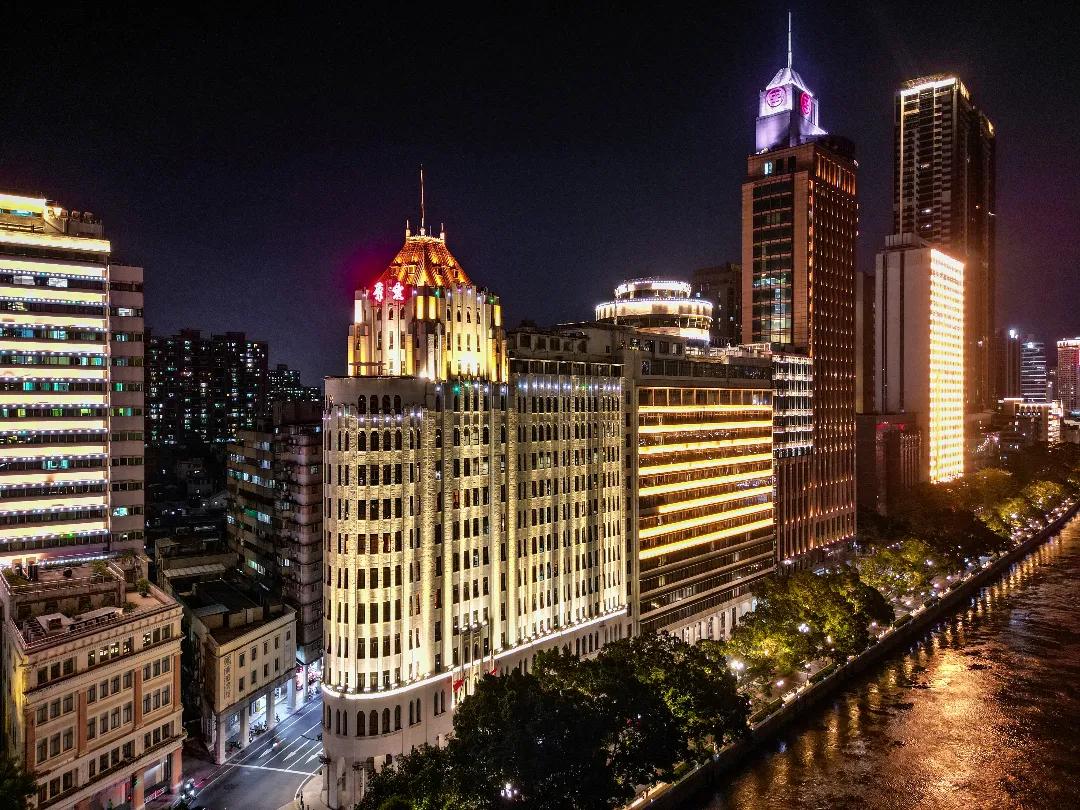Navigating Yuexiu district through landmarks and cuisine
BY :SilkRoadPost
UPDATED :2024-05-23
Living in Guangzhou, people may relish the experience of walking on streets of Yuexiu, a district where restaurants, eateries and scenic spots are always adjoining each other. Today, SilkRoadPost will recommend a day trip route for you to make city walks while enjoying cuisine.

At 8:00 a.m.
Yun Dao (云道) , Luming (鹿鸣) Restaurant, Sun Yat-sen Memorial Hall, Yuexiu Park

Yun Dao is an eight-kilometer trail connecting Sun Yat-sen Memorial Hall and the south gate of Baiyun Mountain, which passes Yuexiu Park, Huaguoshan Park, Sculpture Park and Luhu Park. Visitors will be close to nature as they walk through mountains, streams and vast stretches of grass.
Luming Restaurant has been one of the most famous garden-style restaurants in Guangzhou since it started business in the 1980s. Customers are able to have dim sum breakfast in the 40-year-old lakeside restaurant, tasting egg tart, crispy durian cake and barbecued pork pastry.

After taking a sip of herbal tea or lemon tea on some street stand, city walkers can explore two spots along Yun Dao, namely Sun Yat-sen Memorial Hall and Yuexiu Park.
Inaugurated in 1931, Sun Yat-sen Memorial Hall was the largest hall-style architecture of its time in Asia and is still the biggest of its kind globally. The state-of-the-art steel structure alongside reinforced concrete were adopted in the construction, creatively combining western techniques with Chinese traditional architectural craftsmanship. It was also listed as one of the key protected sites and the first batch of architectural heritages in the 20th century of China.

Yuexiu Mountain stands as the last hilly land of Baiyun Mountain. Before the Ming Dynasty (1368-1644), Yuexiu was the primary mountain of Guangzhou. After Ming, its main mountain range became the starting point of ancient Guangzhou's central axis. Over 2,000 years ago, Yuexiu Mountain was a coastal area whose southern part could meet the roaring waves of the South Sea. With an altitude of 70 meters, it was also deemed as a high land of the city.

At 12:00 p.m.
Xin Tai Le (新泰乐) Restaurant

A good option for lunch is Xin Tai Le, a reputed restaurant recorded in Michelin Guide. The food-stand-turned-restaurant is famous for eel casserole, rice with eel, barbecued pork (char siu), goose intestine and poached chicken (Bai Qie Ji).
At 3:00 p.m.
Shawan (沙湾) dessert, Temple of the Six Banyan Trees (Liurong Temple) , Guangxiao (光孝) Temple

In the afternoon, your taste bud can be delighted by having a bite of Shawan (an ancient town located in Panyu district of Guangzhou) dessert, such as red bean paste, lotus seed sweet soup, double-layer steamed milk, ginger milk curd and chilled mango sago cream with pomelo.

Temple of the Six Banyan Trees is a centuries-old temple that is renowned both at home and abroad. It is marked by the Flower Pagoda, which was named for its colorful exterior.
Another monastery, Guangxiao Temple, is the oldest and largest Buddhist temple in the city. The main hall, Mahavira Hall, has two towers and enshrined with three Buddha figures.

At 4:00 p.m.
Beijing Lu, Huifu (惠福) Food Street

Beijing Lu is a hub for various authentic snacks, such as beef offal, bowl rice pudding of Bu Bu Gao Sheng (步步高昇), a well-known eatery, and fish skin salad from Chen Tian Ji (陈添记), a noted snack bar.
Since the founding of Guangzhou, Beijing Lu has been the starting point of urban construction, which also serves as one of the oldest city axes of China.

Over 20 years ago, 11 layers of pavements from the Tang Dynasty (618-907) to the Republic of China era (1911-1949) were unearthed from the northern section of Beijing Lu. Meanwhile, the ancient site of the five-storey Gongbei (拱北) Building, which dated back from the Song Dynasty (960-1279) to the Ming and Qing dynasties (1368-1911), were discovered in the southern section of the road. All the ruins are now on display at the original site with protection of reinforced glass shield.
Adjoining Beijing Lu Pedestrian Street, Huifu Food Street gathers some 75 snack stands and restaurants, selling specialty food of Lingnan region and Southeast Asian countries.
At 6:00 p.m.
Yanjiang (沿江) Lu, Tianzi (天字) Wharf , Yongli (永利) Restaurant

Yanjiang Lu boasts a number of restaurants offering authentic Cantonese-style dishes, like Guangzhou Restaurant and Yongli Restaurant.
Commonly known as the ferry terminal on the Pearl River that has been operational for the longest time in the city, Tianzi Wharf boasts a history of more than 270 years. In the seventh year of the reign of Emperor Yongzheng (1723-1735) in the Qing Dynasty, it was designated as the wharf of imperial court to pick up and send off officials when they arrived or left Canton.
Now, Tianzi Wharf is the inception point of the Pearl River Night Cruise for visitors to enjoy the scenery along the reaches between Bai’e tan (白鹅潭) and Liede (猎德) Bridge.
For diners of Yongli Restaurant, they can enjoy an unimpeded night view of the Pearl River alongside signature dishes, including sugar puff doughnuts, Siu Mai with quail egg, bullfrog dipped in ginger oil, etc.

At 10:00 p.m.
Aiqun (爱群) Building, Xinji (信记) Seafood Restaurant

In 1937, Aiqun Building was completed and put into use. The 15-storey building has a height of 64 meters, ranking the first in the city for as long as 30 years until it was surpassed by Guangzhou Hotel.
The earliest revolving restaurant in China was established in Aiqun, which became a long-cherished place of tons of youngsters. Now, the newly-open restaurant Oikwan Bistro wins the hearts of young customers again by the creative and well-displayed dishes.

Xinji, a seafood restaurant that has been running for over 40 years, displays on menus over 10 methods of making seafood, as the purchasers buy fresh ingredients on a daily basis. Their specialties include turbots and wok-fried rice with silver-stripe round herrings.

Source: 广州越秀发布
Author: Liu Liu








